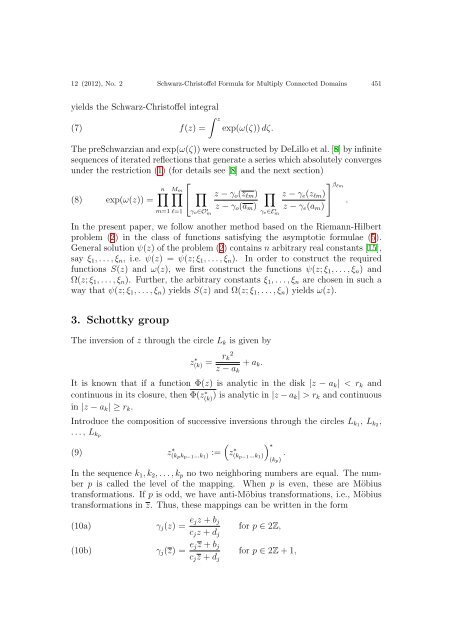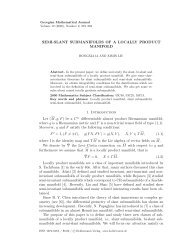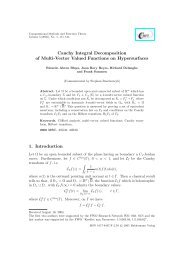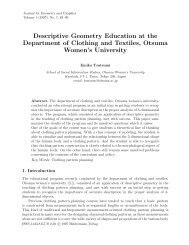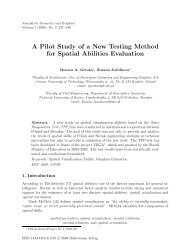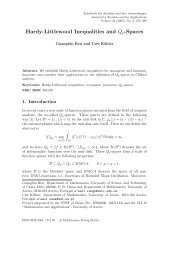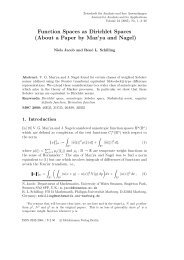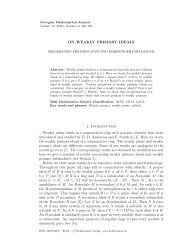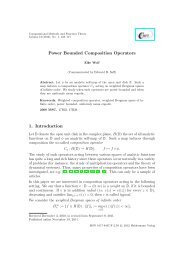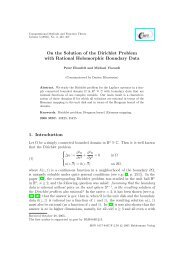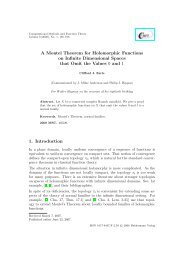Schwarz-Christoffel Formula for Multiply Connected Domains
Schwarz-Christoffel Formula for Multiply Connected Domains
Schwarz-Christoffel Formula for Multiply Connected Domains
You also want an ePaper? Increase the reach of your titles
YUMPU automatically turns print PDFs into web optimized ePapers that Google loves.
12 (2012), No. 2 <strong>Schwarz</strong>-<strong>Christoffel</strong> <strong>Formula</strong> <strong>for</strong> <strong>Multiply</strong> <strong>Connected</strong> <strong>Domains</strong> 451<br />
yields the <strong>Schwarz</strong>-<strong>Christoffel</strong> integral<br />
(7) f(z) =<br />
∫ z<br />
exp(ω(ζ)) dζ.<br />
The pre<strong>Schwarz</strong>ian and exp(ω(ζ)) were constructed by DeLillo et al. [8] by infinite<br />
sequences of iterated reflections that generate a series which absolutely converges<br />
under the restriction (1) (<strong>for</strong> details see [8] and the next section)<br />
⎡<br />
⎤<br />
(8) exp(ω(z)) =<br />
n∏ ∏M m<br />
⎣ ∏<br />
m=1 l=1<br />
γ o∈O ′ m<br />
z − γ o (z lm )<br />
z − γ o (a m )<br />
∏<br />
γ e∈E ′ m<br />
z − γ e (z lm )<br />
z − γ e (a m )<br />
⎦β lm<br />
.<br />
In the present paper, we follow another method based on the Riemann-Hilbert<br />
problem (2) in the class of functions satisfying the asymptotic <strong>for</strong>mulae (5).<br />
General solution ψ(z) of the problem (2) contains n arbitrary real constants [15],<br />
say ξ 1 , . . . , ξ n , i.e. ψ(z) = ψ(z; ξ 1 , . . . , ξ n ). In order to construct the required<br />
functions S(z) and ω(z), we first construct the functions ψ(z; ξ 1 , . . . , ξ n ) and<br />
Ω(z; ξ 1 , . . . , ξ n ). Further, the arbitrary constants ξ 1 , . . . , ξ n are chosen in such a<br />
way that ψ(z; ξ 1 , . . . , ξ n ) yields S(z) and Ω(z; ξ 1 , . . . , ξ n ) yields ω(z).<br />
3. Schottky group<br />
The inversion of z through the circle L k is given by<br />
z ∗ (k) = r k 2<br />
z − a k<br />
+ a k .<br />
It is known that if a function Φ(z) is analytic in the disk |z − a k | < r k and<br />
continuous in its closure, then Φ(z ∗ (k) ) is analytic in |z − a k| > r k and continuous<br />
in |z − a k | ≥ r k .<br />
Introduce the composition of successive inversions through the circles L k1 , L k2 ,<br />
. . . , L kp<br />
( ) ∗<br />
(9) z(k ∗ pk p−1 ...k 1 ) := z(k ∗ p−1 ...k 1 ) .<br />
(k p)<br />
In the sequence k 1 , k 2 , . . . , k p no two neighboring numbers are equal. The number<br />
p is called the level of the mapping. When p is even, these are Möbius<br />
trans<strong>for</strong>mations. If p is odd, we have anti-Möbius trans<strong>for</strong>mations, i.e., Möbius<br />
trans<strong>for</strong>mations in z. Thus, these mappings can be written in the <strong>for</strong>m<br />
(10a)<br />
(10b)<br />
γ j (z) = e jz + b j<br />
c j z + d j<br />
<strong>for</strong> p ∈ 2Z,<br />
γ j (z) = e jz + b j<br />
c j z + d j<br />
<strong>for</strong> p ∈ 2Z + 1,


